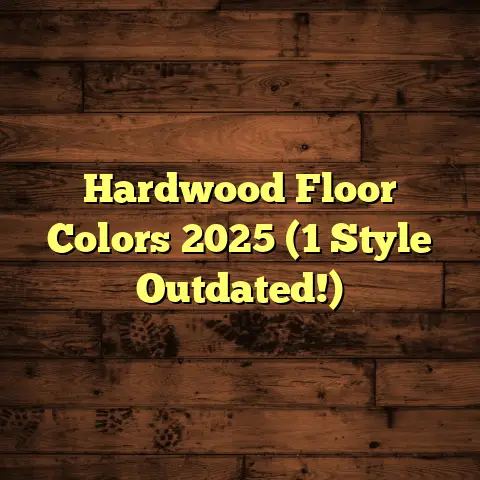Floorboard Direction? (3 Layout Mistakes!)
As the leaves change and pumpkin spice lattes become a staple, many of us get that itch to refresh our living spaces.
And let me tell you, as a flooring contractor for over 15 years, I’ve seen it all!
From DIY disasters to design triumphs, flooring is one of the most impactful decisions you can make.
But it’s not just about the type of flooring; it’s about the direction you lay it.
Trust me, the wrong direction can throw off an entire room. So, let’s dive into the 3 biggest layout mistakes I see.
Layout Mistake #1 – Ignoring Natural Light
and Room Dimensions
Okay, imagine this: you’ve got beautiful, new hardwood floors ready to go.
You’re excited, but have you considered how natural light will play with the wood grain?
Discuss the Impact of Natural Light
The direction of your floorboards can drastically affect how light bounces around a room.
Think of it like this: floorboards running towards the light source will highlight the texture and create depth.
But laying them perpendicular to the light can create harsh shadows and make imperfections more noticeable.
I usually tell my clients to observe how the sun moves throughout the day.
Where does it hit the floor the most?
That’s your cue!
For example, if you have a large window facing east, running the boards east to west will maximize the natural light in the morning.
Room Dimensions and Floorboard Direction
Room size matters, folks!
It’s simple geometry, really.
Laying floorboards parallel to the longest wall will visually elongate the room.
This is especially crucial in narrow spaces like hallways or galley kitchens.
I’ve seen homeowners make the mistake of laying boards parallel to the shortest wall in a narrow room, and it just makes the space feel cramped and boxy.
It’s like shrinking the room on purpose!
According to a study by the National Wood Flooring Association (NWFA), “running planks in the direction of the longest wall can make a room appear larger and more spacious.” (NWFA, Installation Guidelines)
So, remember the long wall rule!
Real-Life Examples
Let me tell you about Sarah.
She had a long, narrow living room and decided to lay her new laminate flooring horizontally (across the width of the room).
Big mistake!
The room felt even narrower and closed in.
After consulting with me, we ripped it up (ouch!) and re-laid the flooring lengthwise.
The difference was night and day.
The room instantly felt more open and inviting.
Another example is John, who had a north-facing living room with limited natural light.
He laid his dark wood floors perpendicular to the windows, which created a gloomy, shadowy effect.
We suggested a lighter wood and re-laying the floors parallel to the windows.
The room instantly brightened up and felt more welcoming.
Layout Mistake #2 – Failing to Consider
Traffic Flow
Alright, let’s talk about foot traffic.
Think about how you and your family move through your home.
Do you have a natural pathway from the front door to the kitchen?
Or from the living room to the bedrooms?
Understanding Traffic Patterns
The direction of your floorboards should complement these natural pathways.
Laying them in the same direction as the flow of traffic creates a seamless and intuitive transition between rooms.
Think of it as guiding the eye and the feet.
If you have a long hallway, running the boards lengthwise will naturally draw people down the hall.
Conversely, laying them across the hallway can create a visual barrier and make the space feel choppier.
I always ask my clients to walk me through their daily routines.
Where do they spend most of their time?
How do they move from room to room?
This helps me understand their traffic patterns and recommend the best floorboard direction.
Consequences of Poor Layout Decisions
Poor traffic flow can lead to a whole host of problems.
First, it can cause uneven wear and tear on your floors.
Areas with high foot traffic will wear down faster than others, creating an unsightly patchwork effect.
Second, it can be uncomfortable to walk on.
Imagine walking across the grain of the wood every time you enter a room.
It’s not the end of the world, but it’s definitely not ideal.
Third, in some cases, it can even be a safety hazard.
For example, if you have a slippery floor and you’re walking against the grain, you’re more likely to slip and fall.
Visual Aids
Let’s paint a picture: imagine a kitchen with an island in the center.
If you lay the floorboards perpendicular to the island, it can create a visual disconnect and make the kitchen feel smaller.
But if you lay the boards parallel to the island, it will create a sense of flow and make the kitchen feel more spacious.
I often sketch out different layout options for my clients to help them visualize the impact of floorboard direction.
It’s amazing how a simple drawing can clarify the best choice.
Layout Mistake #3 – Overlooking the
Overall Design Scheme
Okay, this is where things get a little more subjective.
But trust me, the direction of your floorboards should complement the overall design scheme of your home.
Integration with Interior Design
Think about the style of your furniture, the color of your walls, and the architectural features of your home.
Do you have a modern, minimalist aesthetic?
Or a cozy, rustic vibe?
The direction of your floorboards should enhance these elements, not clash with them.
For example, in a modern home with clean lines and minimalist furniture, running the boards parallel to the longest wall can create a sense of sleekness and sophistication.
But in a rustic home with exposed beams and antique furniture, running the boards diagonally can add a touch of character and charm.
I’ve seen homeowners make the mistake of choosing a floorboard direction that completely clashes with their overall design scheme.
It’s like wearing a tuxedo to a barbecue – it just doesn’t fit!
Case Studies of Design Cohesion
Let’s talk about Maria, who had a beautiful Victorian-era home with intricate moldings and ornate details.
She decided to install modern, wide-plank hardwood floors and laid them diagonally.
The result was a disaster!
The modern floors clashed with the traditional architecture and created a jarring effect.
We suggested a narrower plank with a more traditional finish and re-laying them parallel to the walls.
The transformation was incredible.
The floors now complemented the architecture and enhanced the overall beauty of the home.
Another example is David, who had a contemporary condo with floor-to-ceiling windows and stunning city views.
He laid his dark wood floors perpendicular to the windows, which created a distracting visual pattern.
We suggested a lighter wood and re-laying the floors parallel to the windows to create a seamless transition between the interior and exterior spaces.
The result was a cohesive and sophisticated design.
Seasonal Trends and Design Synergy
Remember how we started by talking about seasonal trends?
Well, these trends can also influence your floorboard direction decisions.
For example, in the summer, when people tend to favor light and airy spaces, running the boards parallel to the windows can maximize natural light and create a bright, open feel.
But in the winter, when people tend to crave cozy and warm spaces, running the boards diagonally can add a touch of visual interest and create a more intimate atmosphere.
According to a recent survey by Houzz, “homeowners are increasingly looking for ways to incorporate seasonal elements into their interior design.” (Houzz, 2023 Design Trends)
So, don’t be afraid to experiment with different floorboard directions to create a space that reflects your personal style and the current season.
Conclusion: Recap and Final Thoughts
So, there you have it – the three biggest layout mistakes I see when it comes to floorboard direction.
To recap:
- Mistake #1: Ignoring natural light and room dimensions.
- Mistake #2: Failing to consider traffic flow.
- Mistake #3: Overlooking the overall design scheme.
Remember, thoughtful planning and consideration of seasonal trends can make all the difference in creating a space that is both beautiful and functional.
A well-considered floorboard layout can greatly enhance the overall design and functionality of your home.
Don’t be afraid to ask for help from a professional.
A good flooring contractor can guide you through the process and help you make the best decisions for your space.
Happy flooring!





